The Doge's Palace is the luxurious residence of the ancient Venetian government. Doge's Palace.
An architectural monument of Italy, made in the Gothic style.
The author of the project is Filippo Calendario. The construction of the palace took place over 115 years, 1309-1424. In 1577 there was a fire that significantly damaged the building. The palace was restored in the old style, despite the fact that it was the dawn of Renaissance architecture. The building was the residence of the Doges. The Doge is the head of the board of the Venetian Republic, who was elected for life through multi-stage voting. Applicants for the position of Doge came from the most influential families of Venice. The Doge's Institute existed for more than a thousand years; it was abolished by Napoleon in 1797.
Also in the palace were the Senate, the Grand Council, the Collegium, the Supreme Court, the Navy Department, the secret police and other representatives of the state apparatus. The Doge's Palace differs from its contemporary palaces in that it is not a fortress.
The palace is a three-story building in the shape of the Russian letter “P”, made of gray, white and pink marble. The building has two facades that form a right angle. The first floor is a gallery of arches pointed upward, supported by columns. The second floor is also formed by columns, but less thick and higher, and in the upper part there is a row of boxes decorated with a quatrefoil pattern. The third floor is a smooth wall, lined with white marble, which is cut through by large and small windows. On the southern facade there is a balcony, which was the Doge's tribune. Above the balcony is the Monument to Justice by Alessandro Vittoria.
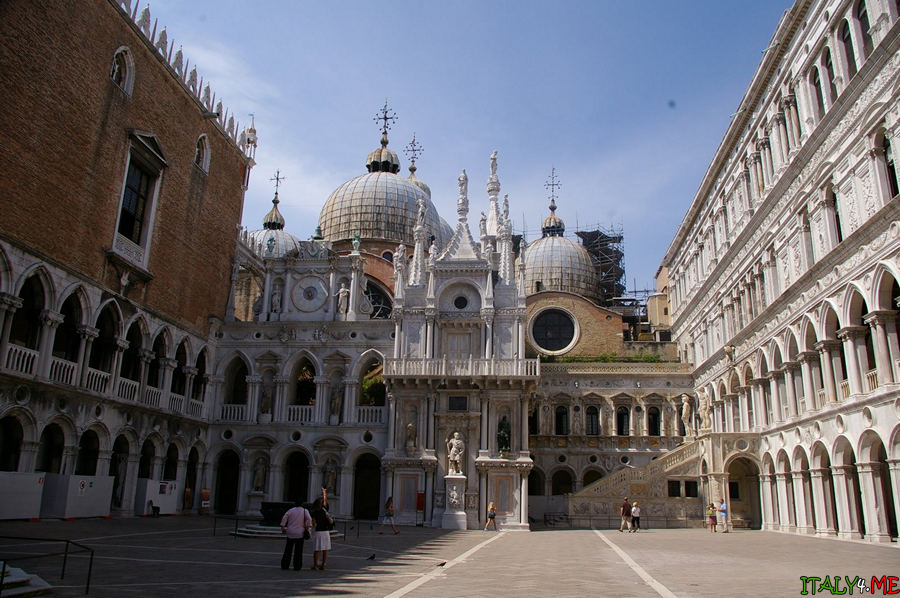
The perimeter wall is topped with openwork white marble battlements. The palace has two main entrances; - Porta della Carta (paper gate) - the main entrance of the Doge's Palace. Above the gate is a winged lion with Doge Francesco Foscari kneeling in front of it. The gates were called paper gates because of the tradition of posting notices on them. - Porta del Frumento (wheat gate) - overlooks the embankment and is the starting point for excursions around the palace.
Italian artist Francesco Guardi depicted the palace in the paintings "Doge's Palace in Venice" - located in the London National Gallery,

and "The Doge's Audience in the Council Chamber of the Doge's Palace" is in the Louvre Museum in Paris.
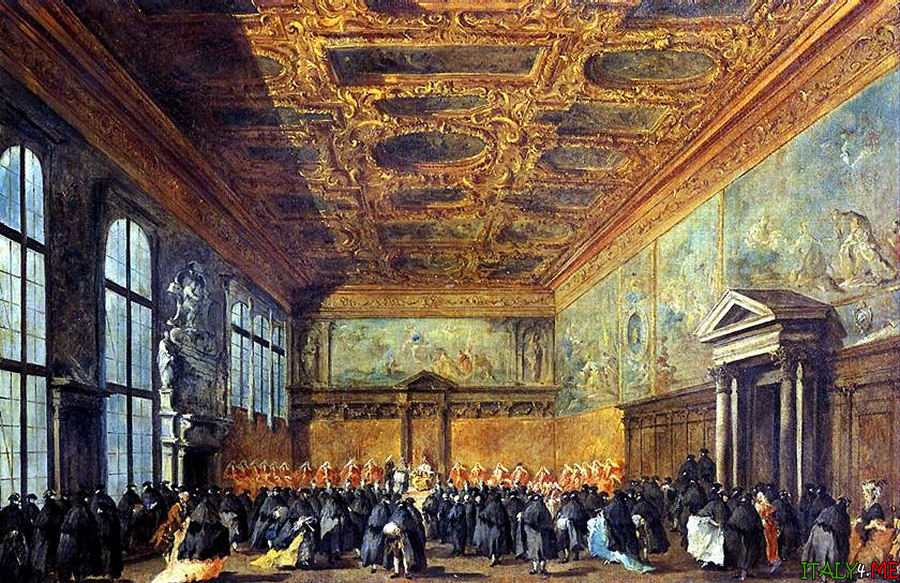
Today, the Doge's Palace, which keeps many secrets and legends, attracts crowds of tourists. You can lift the veil of the unknown with a two-hour excursion costing 10 euros per person.
Official website: palazzoducale.visitmuve.it – you can immediately order tickets online for 20 euros to avoid standing in lines.
View on a larger map
The Doge's Palace in Italy is the greatest architectural monument of the city. Once here was the residence of the rulers of the Venetian Republic, the most powerful, rich and developed maritime state in the Middle Ages. And now there is a museum and crowds of tourists from all over the world. The main wealth of the palace for tourists and numerous excursion groups is its coolness (surprisingly, even in the forty-degree heat in Venice you can rarely find air conditioning), which is very important in the summer and ceiling frescoes with stucco. If you have a cold in your neck, come back another time: you will have to look mainly at the ceiling.
Over the years of its existence, the palace managed to be the seat of the government of the Venetian Republic, the meeting place of the Council and the Grand Senate, and a haven for the secret police. The palace has a lot of secret staircases and corridors into which tourists are allowed. But be careful, it's very easy to get lost!
The architecture of the Doge's Palace is very eclectic, since it was built and completed at different times throughout the glorious history of its existence. The current one is the fourth palace in a row. The first building was erected in Antiquity; judging by the excavations, it was a fortress. During the uprising in the 10th century it was destroyed. In 1106, the second burned down, and the third was destroyed by the Venetians themselves, as it did not correspond to the Venetians’ idea of the greatness of the state.
The current palace was probably built in the 12th century. At that time, the usual castles with thick walls were not built in the city. The sea is the main fortification, and the well-trained Venetian fleet is its defense. The chief architect of the Doge's Palace was Filippo Calendario, who significantly improved its appearance. Lombard and Florentine artisans were brought in for the final construction, and most of the building was built and decorated by the Bon dynasty, Venetian marble craftsmen.
Peculiarities
The Doge's Palace is the only building in the world where the basic laws of architecture are resorted to only occasionally. At first it seems illogical that the massive part of the palace stands on light, openwork arches; the palace seems to be upside down. But despite this, every detail of the architectural composition fits perfectly together. The appearance of the palace is pleasant to look at. The open arcade gallery on the first floor is a place where you can hide from the scorching sun in summer. It’s nice to relax here and enjoy the beauty of the palace’s exterior.
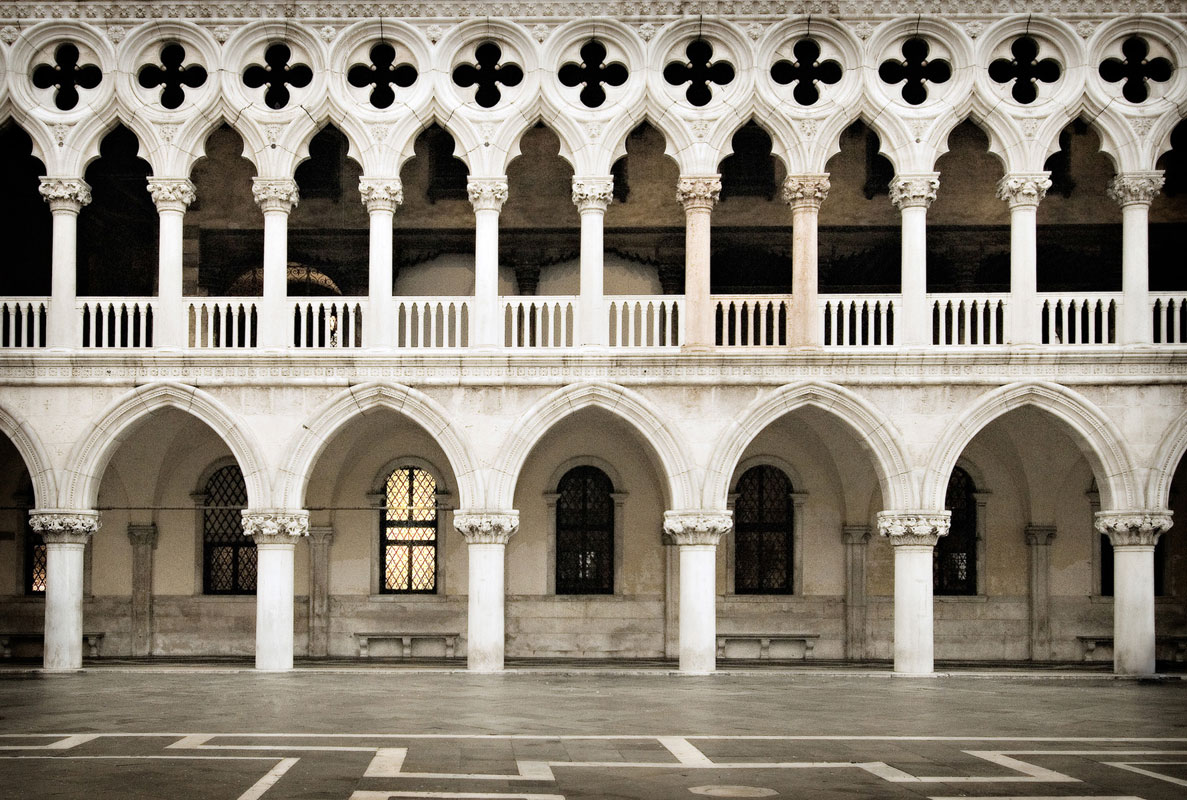
Doge's Museum
It will take you a few hours if you wish to explore the palace on your own. If you have time and energy left, be sure to go on the interesting “Secret Routes” excursion: secret staircases, torture chambers, piombi - prison cells under the roof (Casanova was thrown there without charges). In general, the police side of the Venetian state, which cannot be seen with regular entrance tickets.The Doge's Palace in Piazza San Marco, a full member of its magnificent, world-famous architectural ensemble, has, so to speak, a dual character. From the outside, the Doge's Palace, the main administrative building of the once powerful Venetian Republic, looks openwork, graceful, almost weightless; inside, its interiors and paintings amaze with their gloomy, oppressive and even some kind of sinister beauty.
The Venetian aristocrats knew a lot about luxury like no other, and visitors - be they foreign envoys or their own citizens - had to immediately understand where (and to whom) they were going for an audience.
A little history
The building of the Doge's Palace that you see today appeared inXIV- XVcentury, it was built over a hundred years from 1309 to 1424, and the architect Filippo Calendario is indicated as the supposed author of the project. Architectural style of the Doge's Palace: Gothic.
However, already in 810 there was a building on this site that performed administrative functions, but it was not a palace, but a fortress. The power of Venice gradually grew, and the need for a fortress disappeared - the republic was defended by an excellent, strong fleet. This is how the current Palace appeared.
Throughout history, several times throughout history, the residence of the rulers of Venice was subject to devastating fires - sometimes as a result of riots and arson by angry citizens, sometimes by accident, a fate that almost none of the medieval castles escaped. After any damage, the Palace was rebuilt by the best Venetian architects, as a result of which the style gradually changed from Gothic to Renaissance.
The artists, architects and sculptors who worked on the design of the facade, interiors and painting of the walls and ceilings of the Doge's Palace are a whole galaxy of masters from the heyday of the Venetian Republic. Today, inside you will see works by Pietro Lombardo, Jacopo and Domenico Tintoretto, Titian, Veronese and many, many others. Alas, the great fire of 1577 destroyed many original masterpieces stored in one wing of the palace, so these are works that were later restored.
Halls of the Doge's Palace
During a tour of the Doge's Palace, you pass through the halls in which all the authorities of the Venetian Republic were based. The ruler himself, the Doge, was located here, the Grand Council (a special Venetian body) and the Senate met, the justice authorities, the Inquisition and other departments were located. Here, not far away, after the verdicts were announced, the convicts languished in the prison premises.
I will list the most important and interesting halls of the Palace Museum.
By the way, be prepared that after visiting it your neck may hurt: almost all the ceilings of the halls are so magnificent that you O Most of the time you walk around the Palace with your head up.
So, after passing through the museum’s ticket office and a small room with antique columns and other artifacts, you find yourself in the courtyard of the Palace. Take your time to enter, but pay attention to some of the architectural details, arches and sculptures.
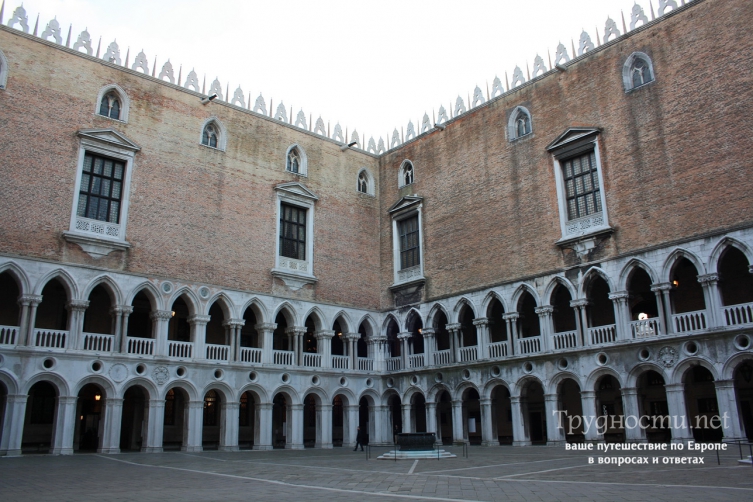
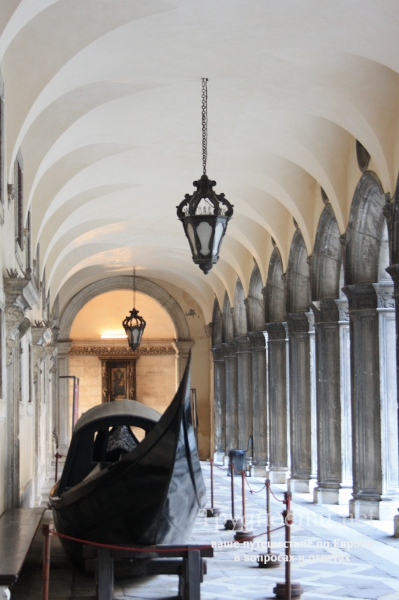


Then by Giant's Staircase you go up to the Palace and begin your inspection. On the Staircase there are two statues - Mars and Neptune, personifying the power of Venice, which extended to both land and sea. You can also walk a little on the balconies.
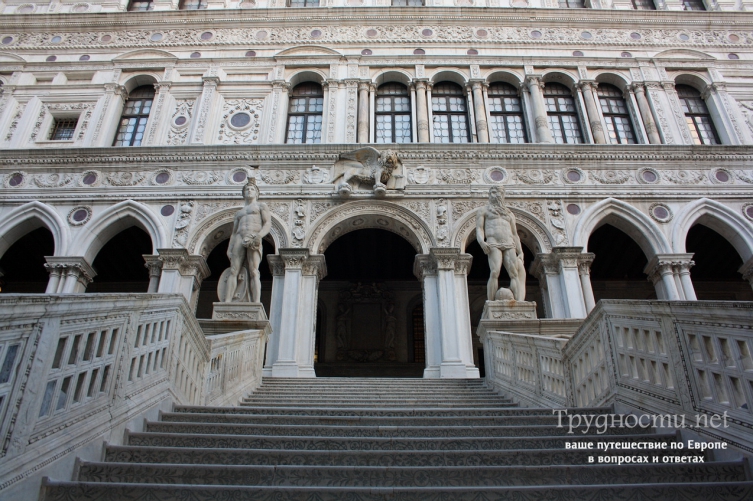


Immediately upon entering, it leads upstairs Golden staircase- another masterpiece among others, after which you find yourself in several halls and smaller rooms, which served as the personal apartments of the Venetian Doge. They were all mostly located upstairs and had a view of the lagoon.



A room called Liago in Venetian dialect meant a terrace or balcony covered with a glass roof. This was a place (essentially a corridor) where members of the aristocratic families of Venice could stroll between meetings and communicate with each other, solving various issues. Next comes Council Chamber of the Forty(judicial panel). Its members resolved political and economic issues, and also managed criminal and civil proceedings.
Grand Council Hall occupies the entire southern wing of the Palace. This is an impressive hall, considered the largest of its kind in all of Italy (54 meters long, 25 meters wide, 15 meters high). It was he who was decorated with paintings and paintings by Pisanello, Bellini, Gentile da Fabriano, Tintoretto, Titian, Veronese and other outstanding masters, but they completely burned down in the fire of 1577. In 1590, Jacopo Tintoretto and his son Domenico created a new painting, “Paradise,” and Veronese created a large canvas called “The Triumph of Venice,” and the Hall was subsequently restored. All male members of noble Venetian families over 25 years of age took part in the meetings of the Great Council. All other authorities of the republic had to obey the decisions of the Council.
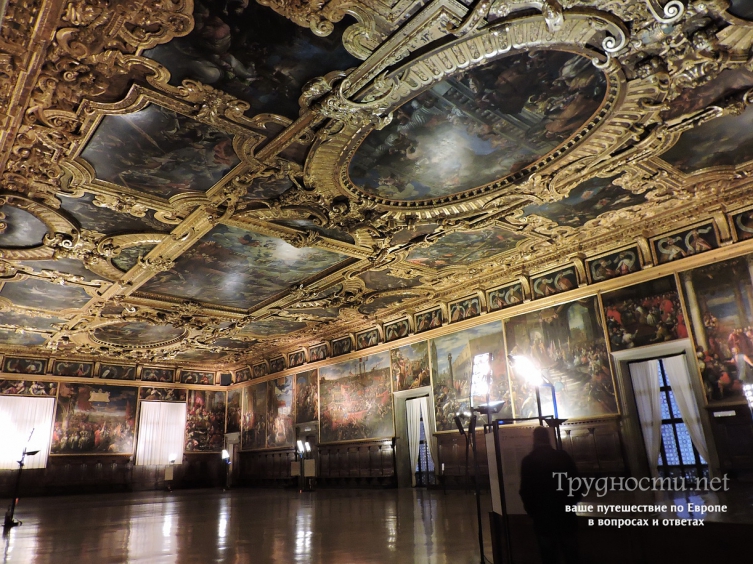
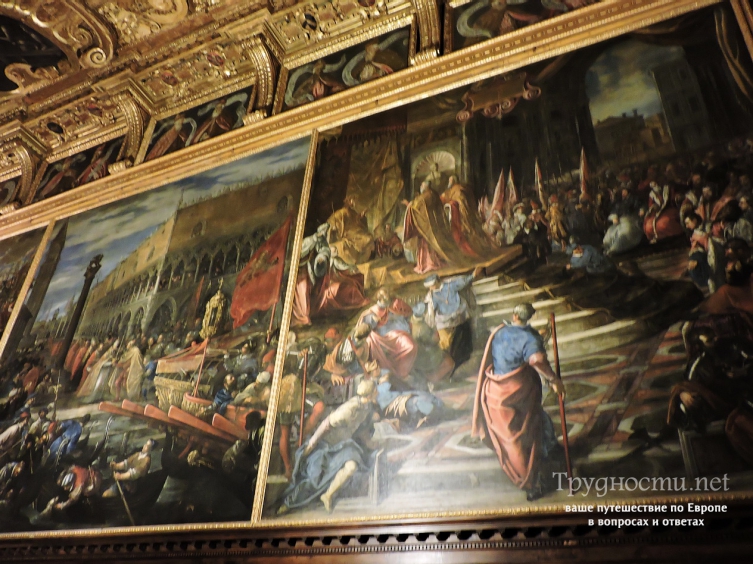
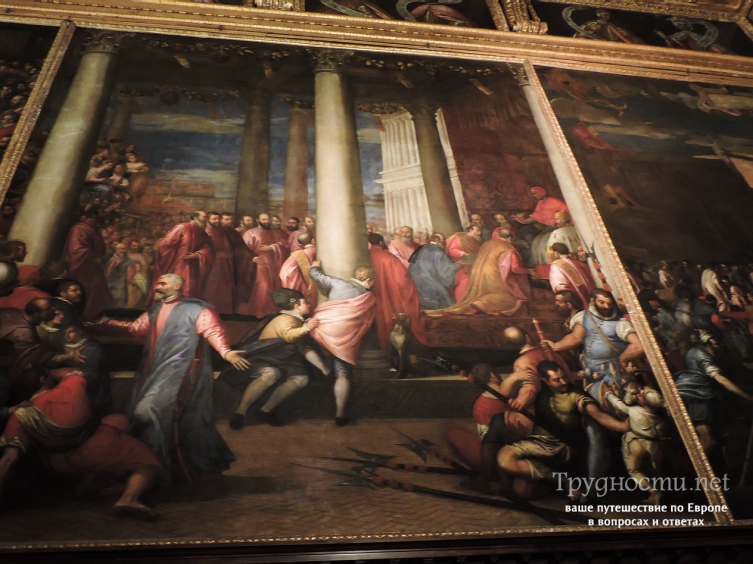
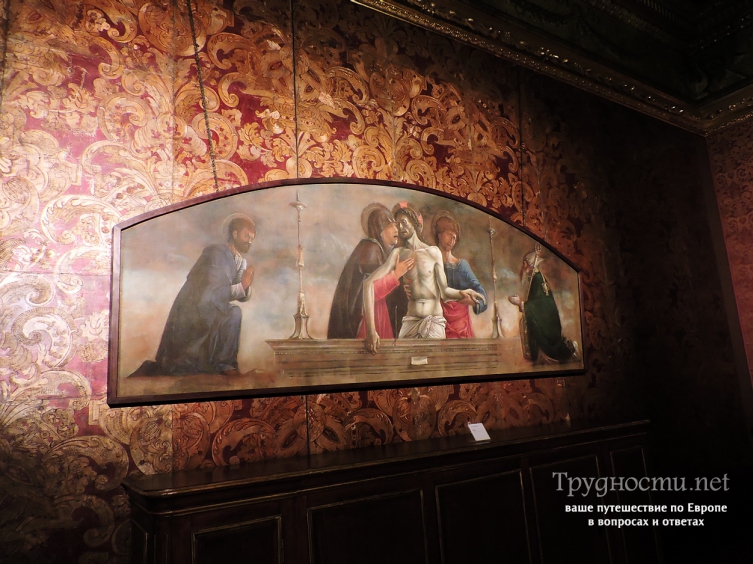
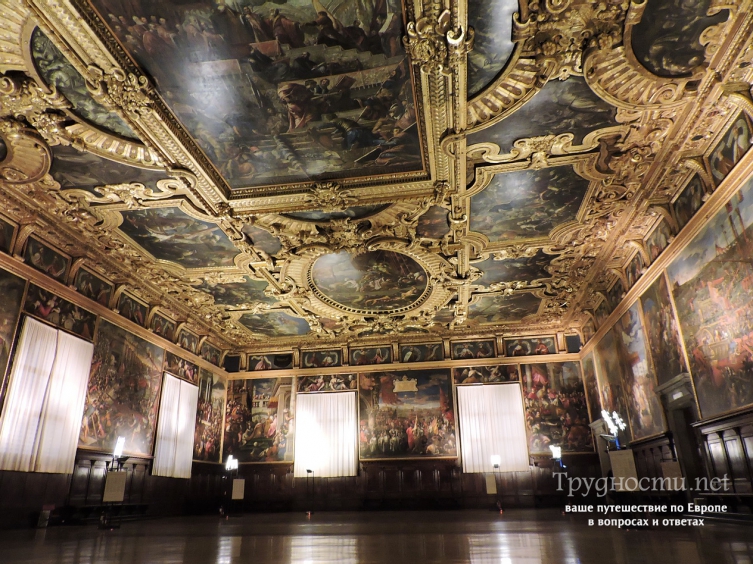
Under the ceiling of the hall there is a frieze with portraits of all the Doges of the Venetian Republic, except one, Marino Falier, who was executed for attempting a coup. In place of his supposed portrait there is a black canvas, which was supposed to symbolize the oblivion of the traitor.
Election Hall- the next hall in which visitors find themselves after leaving the Great Council Hall. Compass Hall served as a refuge for the Inquisition. It was here that a denunciation could be brought and dropped into a special “mailbox” in the shape of a lion’s mouth. Hall of the Council of Ten- one of the central administrative halls, which served as a meeting place for the so-called Venetian Council of Ten. This was a special body, consisting of high-ranking residents of the Venetian Republic, which decided the fate of political criminals.
Scarlatti Hall, Hall of cards, College Hall, Senate Chamber– the remaining most significant halls of the Doge's Palace. Several halls are also reserved for large weapons collection different periods of the existence of the Venetian Republic.




After the weapons, the visit to the Palace Museum ends with an inspection of such objects as the corridor through the famous Bridge of Sighs, attached to the side of the Palace Canal and leading to the so-called New Prisons. There are also Old Prisons here, directly in the Palace.
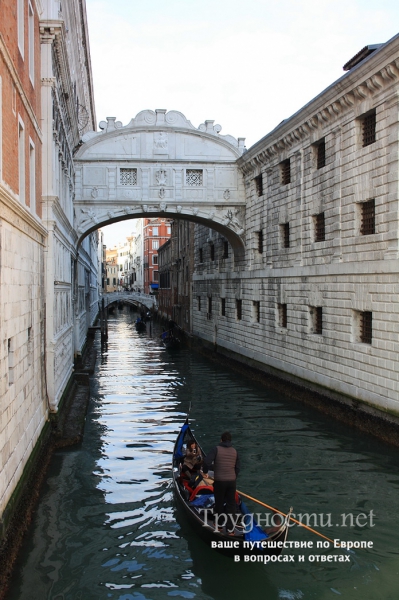
But you most likely will not get to them - the territory of the Palace is very large, you will get a lot of impressions (and not the most pleasant ones). So, when you go out into the fresh air, to the Venetian lagoon, you will most likely take a deep breath with pleasure and think about how good it is to live in the 21st century and not depend on the will of the sinister assembly of influential nobles of the Venetian Republic. In general, complete immersion in the atmosphere is guaranteed. Enjoy your visit!

Opening hours of the Doge's Palace
From March 26 to November 1: from 8.30 to 19.00 (the ticket office closes one hour before the museum closes).
From November 2 to March 25: from 8.30 to 17.30 (the ticket office also closes one hour before the official closing).
The Doge's Palace is closed on January 1st and December 25th.
Address: Piazza San Marco, entrance through Porta del Frumento, from the embankment.
A ticket to the Doge's Palace also gives you access to three other museums in Piazza San Marco - the Archaeological Museum, the Correr Museum and the St. Mark's Library.
Venice
The palace takes its name from the residence of the Doge, the supreme head of the Venetian state. Almost nothing remains of the original structure, built before the year 1000 on the basis of pre-existing Roman walls. This ancient building was destroyed by fire.
The current Doge's Palace was built by stonemasons Filippo Calendario, Pietro Bazeio and master Enrico. In 1400-1404 the façade facing the lagoon was completed, and in 1424 the one facing St. Mark's Square was completed. Florentine and Lombard craftsmen were invited to complete the building, but most of the Gothic style building was carried out by members of the Bon family, Venetian marble specialists. In 1577, another fire destroyed one wing of the building and Antonio da Ponte, the creator of the Rialto Bridge, restored the original appearance of the building.
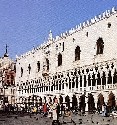 In the center of the eastern facade there is a large balcony, made by Sansovino's students in 1536. Above the balcony there is a lancet window and a sculpture of the Doge Andrea Gritti in front of the symbol of Venice. Above this balcony is a statue of Justice by sculptor Alessandro Vittoria. It was from this balcony that the reunification of Venice with the Kingdom of Italy was proclaimed in 1866.
In the center of the eastern facade there is a large balcony, made by Sansovino's students in 1536. Above the balcony there is a lancet window and a sculpture of the Doge Andrea Gritti in front of the symbol of Venice. Above this balcony is a statue of Justice by sculptor Alessandro Vittoria. It was from this balcony that the reunification of Venice with the Kingdom of Italy was proclaimed in 1866.
To the left of the façade facing St. Mark's Square, access to the courtyard of the Doge's Palace is provided by the Paper Gate - Porta della Carta, created by Giovanni and Bartolomeo Bon; in the shape of a pointed arch, decorated in its upper part with decorative elements in the Gothic style; on the portal is Doge Francesco Foscari in front of a winged lion, and at the top is the Statue of Justice.
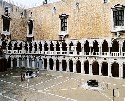 Through the Paper Gate you can enter the arched gallery of Foscari and then into the courtyard of the Doge's Palace, in the center of which there are two bronze parapets for wells by Alfonso Alberghetti (1559) and Niccolò dei Conti (1556), cannon foundries.
Through the Paper Gate you can enter the arched gallery of Foscari and then into the courtyard of the Doge's Palace, in the center of which there are two bronze parapets for wells by Alfonso Alberghetti (1559) and Niccolò dei Conti (1556), cannon foundries.
 The main facade on the east side of the entrance is the work of Antonio Rizzo, late 15th century, luxuriously decorated by Pietro Lombardo. The two facades that frame the courtyard on the south and west sides were built in red brick by Bartolomeo Manopol in the 17th century.
The main facade on the east side of the entrance is the work of Antonio Rizzo, late 15th century, luxuriously decorated by Pietro Lombardo. The two facades that frame the courtyard on the south and west sides were built in red brick by Bartolomeo Manopol in the 17th century.
At the top of the northern facade with the Foscari Arched Gallery there is a clock dial; this facade has two tiers of arches: semicircular in the portico and pointed in the loggia. The arched galleries contain niches with antique restored statues. This façade is also a Baroque work by Manopol. On the right, on a high pedestal, there is a monument to the Duke of Urbino Francesco Maria della Rovere by Giovanni Bandini (1587). In front of the Staircase of the Giants opens the Arch of Foscari, begun by the masters of Bon in the Gothic style and completed by the architect Rizzo in the Renaissance style. Above the building there is a statue of St. Stamp and statues of other allegorical figures. Next to the Giants' Staircase is the Senators' Courtyard. According to tradition, senators gathered here during ceremonies.
 The Giant's Staircase takes its name from the two huge statues of Mars and Neptune that Sansovino and his students sculpted. It was built according to the design of Antonio Rizzo at the end of the 15th century. At the top of the stairs, the ceremony of coronation of the Doges took place. The staircase leads to a covered gallery on the second floor. Along the gallery and inside the palace there are often “mouths of lions” - engraved heads of lions, into which messages and secret denunciations were dropped, which were the competence of various departments.
The Giant's Staircase takes its name from the two huge statues of Mars and Neptune that Sansovino and his students sculpted. It was built according to the design of Antonio Rizzo at the end of the 15th century. At the top of the stairs, the ceremony of coronation of the Doges took place. The staircase leads to a covered gallery on the second floor. Along the gallery and inside the palace there are often “mouths of lions” - engraved heads of lions, into which messages and secret denunciations were dropped, which were the competence of various departments.
The state rooms of the palace can be reached via the Golden Staircase, designed by Sansovino in 1538 for Doge Andrea Gritti and completed by Scarpagnino in 1559. The staircase, covered with gilded stucco, in the old days was intended for important guests and high-ranking officials.
 In the Scarlatti Hall, dignitaries gathered in scarlet togas, awaiting the Doge for official ceremonies. The luxurious decoration of this hall was carried out under the direction of Pietro Lombardo. The rich wooden ceiling dates back to the early 16th century. The elegant marble fireplace bears the coat of arms of Doge Agostino Barbarigo.
In the Scarlatti Hall, dignitaries gathered in scarlet togas, awaiting the Doge for official ceremonies. The luxurious decoration of this hall was carried out under the direction of Pietro Lombardo. The rich wooden ceiling dates back to the early 16th century. The elegant marble fireplace bears the coat of arms of Doge Agostino Barbarigo.
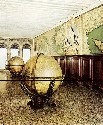 The Hall of Maps takes its name from the important geographical maps adorning the walls, executed by Giovan Battista Ramnusio in 1540, and by Francesco Grisellini and Giustino Menescardi in 1762. In the center of the hall are two large globes dating back to the 17th century.
The Hall of Maps takes its name from the important geographical maps adorning the walls, executed by Giovan Battista Ramnusio in 1540, and by Francesco Grisellini and Giustino Menescardi in 1762. In the center of the hall are two large globes dating back to the 17th century.
The College, consisting of the Doge, six advisers, elders, the head of the Council of Ten and the Supreme Chancellor, met in the College Hall. The most important decisions of the government of the republic were made here. This hall was designed by Antonio da Ponte in 1574. The magnificent gilded carved ceiling was created by Francesco Bello and frames allegorical paintings by Paolo Veronese, among which Venice Enthroned stands out above the podium.
The Senate Hall was also reconstructed by Antonio da Ponte. The drawing of the beautiful ceiling was made by the Veronese Cristoforo Sorte. The panels inserted into it were created by various artists, including Tintoretto.
 A tribunal sat in the hall of the Council of Ten, which conducted investigations concerning political crimes against the state. The Tribunal was headed by the Doge and consisted of ten members of the Grand Council and six advisers. Above this hall were the prison cells, the so-called Piombi, with a lead ceiling, in which Giacomo Casanova and Giordano Bruno were once imprisoned. In the center of the ceiling is Paolo Veronese's masterpiece "Zeus Strikes Down Vices with Lightning", taken by the French to Paris in 1797 and still kept in the Louvre. Currently, a copy of this famous painting made by Jacopo di Andrea is installed on this site.
A tribunal sat in the hall of the Council of Ten, which conducted investigations concerning political crimes against the state. The Tribunal was headed by the Doge and consisted of ten members of the Grand Council and six advisers. Above this hall were the prison cells, the so-called Piombi, with a lead ceiling, in which Giacomo Casanova and Giordano Bruno were once imprisoned. In the center of the ceiling is Paolo Veronese's masterpiece "Zeus Strikes Down Vices with Lightning", taken by the French to Paris in 1797 and still kept in the Louvre. Currently, a copy of this famous painting made by Jacopo di Andrea is installed on this site.
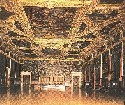 The Grand Council Chamber occupies the entire southern wing. Its length is 54 meters, width - 25 meters, and height - 15 meters. It was decorated with masterpieces by Titian, Veronese, Tintoretto and other famous artists, but they all died in a fire in 1577. The hall was reconstructed according to the design of Antonio da Ponte. Currently, the wall at the back of the hall is completely covered with the painting “Paradise”, painted by Jacopo Tintoretto and his son Domenico (1590). A huge oval painting by Paolo Veronese "The Triumph of Venice" stands out on the ceiling.
The Grand Council Chamber occupies the entire southern wing. Its length is 54 meters, width - 25 meters, and height - 15 meters. It was decorated with masterpieces by Titian, Veronese, Tintoretto and other famous artists, but they all died in a fire in 1577. The hall was reconstructed according to the design of Antonio da Ponte. Currently, the wall at the back of the hall is completely covered with the painting “Paradise”, painted by Jacopo Tintoretto and his son Domenico (1590). A huge oval painting by Paolo Veronese "The Triumph of Venice" stands out on the ceiling.
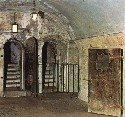
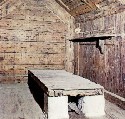 From the halls of the Office of Laws and the Office of Criminal Affairs one can enter a corridor that, passing over the Bridge of Sighs, spanning the Palace Canal, leads to the New Prisons, designed by the architect Antonio da Ponte. There are two corridors along the bridge: the upper one leads to the New Prisons, and the lower one returns to the portico floor of the Doge's Palace. The Old Prisons included Piombi, located under the lead roof of the Palace, and Pozzi, located at the water level of the Palace Canal, in which the most dangerous prisoners were imprisoned. The Pozzi prison cells, due to their wooden lining and squalid space, give the visitor a gloomy feeling, and one can easily imagine the mood of those who were imprisoned here.
From the halls of the Office of Laws and the Office of Criminal Affairs one can enter a corridor that, passing over the Bridge of Sighs, spanning the Palace Canal, leads to the New Prisons, designed by the architect Antonio da Ponte. There are two corridors along the bridge: the upper one leads to the New Prisons, and the lower one returns to the portico floor of the Doge's Palace. The Old Prisons included Piombi, located under the lead roof of the Palace, and Pozzi, located at the water level of the Palace Canal, in which the most dangerous prisoners were imprisoned. The Pozzi prison cells, due to their wooden lining and squalid space, give the visitor a gloomy feeling, and one can easily imagine the mood of those who were imprisoned here.
